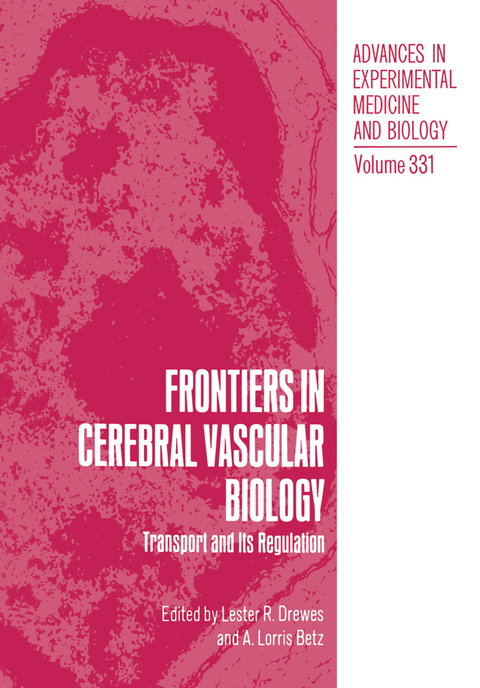
Frontiers in Cerebral Vascular Biology
Springer-Verlag New York Inc.
978-1-4613-6267-8 (ISBN)
Developmental Expression of GlucoseTransporters, GLUT1 and GLUT3, in Postnatal Rat Brain.- Alterations in Brain Glucose Transporter Proteins, GLUT1 and GLUT3, in Streptozotocin Diabetic Rats.- Glucose Transporter (GLUT1) Expression by Canine Brain Microvessel Endothelial Cells in Culture: An Immunocytochemical Study.- Application of Novel PCR Strategies to Amplify and Sequence Glucose Transporters in Canine Brain.- Estimation of Unidirectional Clearances of FDG and Glucose across the Blood-Brain Barrier in Man.- Rat Brain Glucose Concentration and Transport Kinetics Determined With 13C Nuclear Magnetic Resonance Spectroscopy.- Non-Invasive Measurements of the Cerebral Steady-State Glucose Concentration and Transport in Humans by 13C Nuclear Magnetic Resonance.- Potassium Transport at the Blood-Brain and Blood-CSF Barriers.- Expression of Na, K-ATPase at the Blood-Brain Interface.- Effects of Protein Kinase C Agonists on Na, K-ATPase Activity in Rat Brain Microvessels.- Brain Volume Regulation during Development: The Role of Blood-Brain Barrier Potassium Transport.- The Transendothelial DC Potential of Rat Blood-Brain Barrier Vessels in Situ.- Phosphate Transport in Capillaries of the Blood-Brain Barrier.- Drug Delivery to Brain and the Role of Carrier-Mediated Transport.- Vasopressin Modulates the Blood-Brain Transfer of Amino Acids — Studies with [11C]Methionine in Dogs.- Amino Acid Transport at the Blood-Nerve Barrier of the Rat Peripheral Nerve.- Effect of Intra-Uterine Growth Retardation on Cerebral Amino Acid Transport from Birth to Adulthood.- Drug Transfer across the Blood-Brain Barrier: Comparison of in Vitro and in Vivo Models.- Differential Brain Penetration of Cerebroprotective Drugs.- P-Glycoprotein Is Strongly Expressed in Brain Capillaries.- Transport ofProteins Across the Blood-Brain Barrier via the Transferrin Receptor.- Endothelial Cell Biology and the Enigma of Transcytosis through the Blood-Brain Barrier.- Blood-Brain Transport of Vasopressin.- Cerebral Pericytes—a Second Line of Defense in Controlling Blood-Brain Barrier Peptide Metabolism.- The Role of Second Messenger Molecules in the Regulation of Permeability in the Cerebral Endothelial Cells.- Peptidergic Induction of Endothelin 1 and Prostanoid Secretion in Human Cerebromicrovascular Endothelium.- Endothelin-1 Binding to Human Brain Microvascular and Capillary Endothelium: Membranes vs. Intact Cells.- Possible Involvement of C-Kinase in Occurrence of Chronic Cerebral Vasospasm after Subarachnoid Hemorrhage.- A Novel Gene Family May Encode Endothelial Cell Specific Adhesion-Like Molecules: An Extracellular Loop-Repeat-Loop (LRL) Motif and Cytoplasmic Tyrosine Kinase Domains.- Plasminogen Activation and Astroglial-Induced Neural Microvessel Morphogenesis.- Immortalized Rat Brain Microvessel Endothelial Cells: I - Expression of Blood-Brain Barrier Markers during Angiogenesis.- Immortalized Rat Brain Microvessel Endothelial Cells: II-Pharmacological Characterization.- Expression of the HT7 Gene in Blood-Brain Barrier.- Astrocytes Secrete a Factor Inducing the Expression of HT7-Protein and Neurothelin in Endothelial Cells of Chorioallantoic Vessels.- Chorioallantoic Membrane (CAM) Vessels Do Not Respond to Blood-Brain Barrier (BBB) Induction.- Cerebral Endothelium and Astrocytes Cooperate in Supplying Docosahexaenoic Acid to Neurons.- Effect of Cytokines on ICAM Expression and T Cell Adhesion to Cerebrovascular Endothelial Cells.- Expression of Endothelial Cell Activation Antigens in Microvessels from Patients with Multiple Sclerosis.- Generation of anAnti-Mouse Brain Endothelial Cell Monoclonal Antibody That Recognizes 84-110 kDa and 36 kDa Determinants That Are Upregulated by Cytokines.- The Use of Intracerebral Microdialysis to Study Blood-Brain Barrier Transport in Health, after Modification and in Disease.- Cerebral Endothelial Mechanisms in Increased Permeability in Chronic Hypertension.- Altered Fatty Acid Composition of Ethanolamine Phosphoglyceride in Brain Microvessels from Senescent Mouse.- Preirradiation Osmotic Blood-Brain Barrier Disruption Plus Combination Chemotherapy in Gliomas: Quantitation of Tumor Response to Assess Chemosensitivity.- The Uptake of Thyroxine by the Isolated Perfused Choroid Plexus of the Sheep.- Participants.
| Reihe/Serie | Advances in Experimental Medicine and Biology ; 331 |
|---|---|
| Zusatzinfo | 76 Illustrations, black and white; 306 p. 76 illus. |
| Verlagsort | New York, NY |
| Sprache | englisch |
| Maße | 178 x 254 mm |
| Themenwelt | Medizinische Fachgebiete ► Chirurgie ► Neurochirurgie |
| Medizin / Pharmazie ► Medizinische Fachgebiete ► Neurologie | |
| Medizin / Pharmazie ► Medizinische Fachgebiete ► Pharmakologie / Pharmakotherapie | |
| Naturwissenschaften ► Biologie ► Botanik | |
| Naturwissenschaften ► Biologie ► Zoologie | |
| ISBN-10 | 1-4613-6267-9 / 1461362679 |
| ISBN-13 | 978-1-4613-6267-8 / 9781461362678 |
| Zustand | Neuware |
| Informationen gemäß Produktsicherheitsverordnung (GPSR) | |
| Haben Sie eine Frage zum Produkt? |
aus dem Bereich


